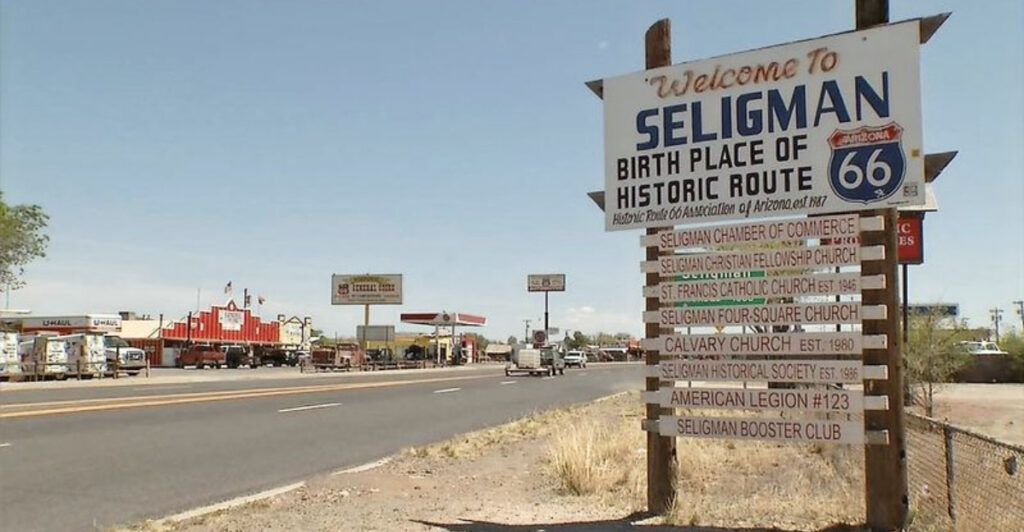Route 66 stretches across America like a ribbon of adventure, connecting small towns and big cities from Chicago to Santa Monica.
This legendary highway offers more than just a drive – it’s a journey through the heart of American culture and history.
Every mile tells a story, from neon-lit diners to quirky roadside attractions that have welcomed travelers for decades. Ready to discover the hidden gems that make this road trip unforgettable?
1. Chicago, Illinois – Where the Adventure Begins
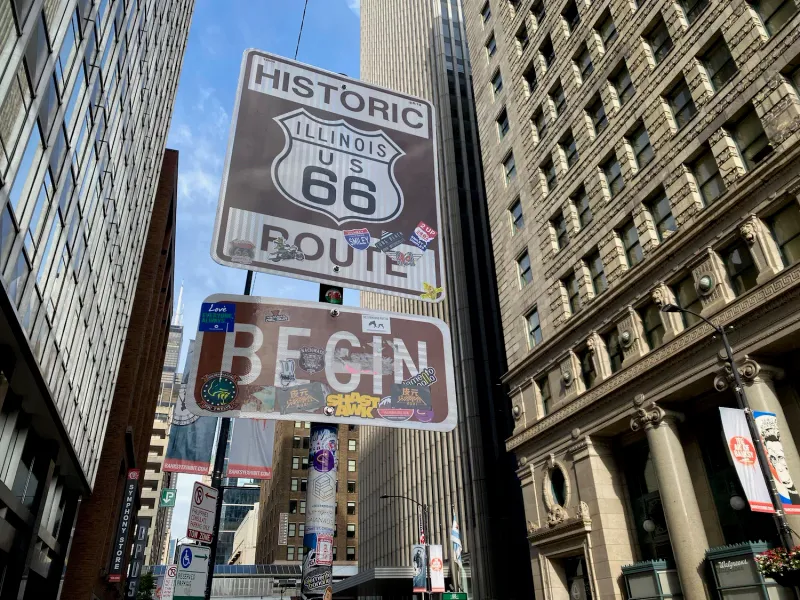
Standing at the starting line of America’s most famous highway, Chicago pulses with energy that sets the perfect tone for your cross-country adventure. The Windy City offers towering skyscrapers, world-class museums, and deep-dish pizza that will fuel your journey ahead.
Before heading west, explore Millennium Park’s famous Bean sculpture or catch a Cubs game at historic Wrigley Field. The city’s vibrant neighborhoods each tell their own story, from the artistic murals of Pilsen to the jazz clubs that still echo with musical history.
Grant Park serves as the official starting point, where Route 66 begins its 2,400-mile journey to the Pacific Ocean.
2. Joliet, Illinois – Blues, Bars, and Infamous Bars
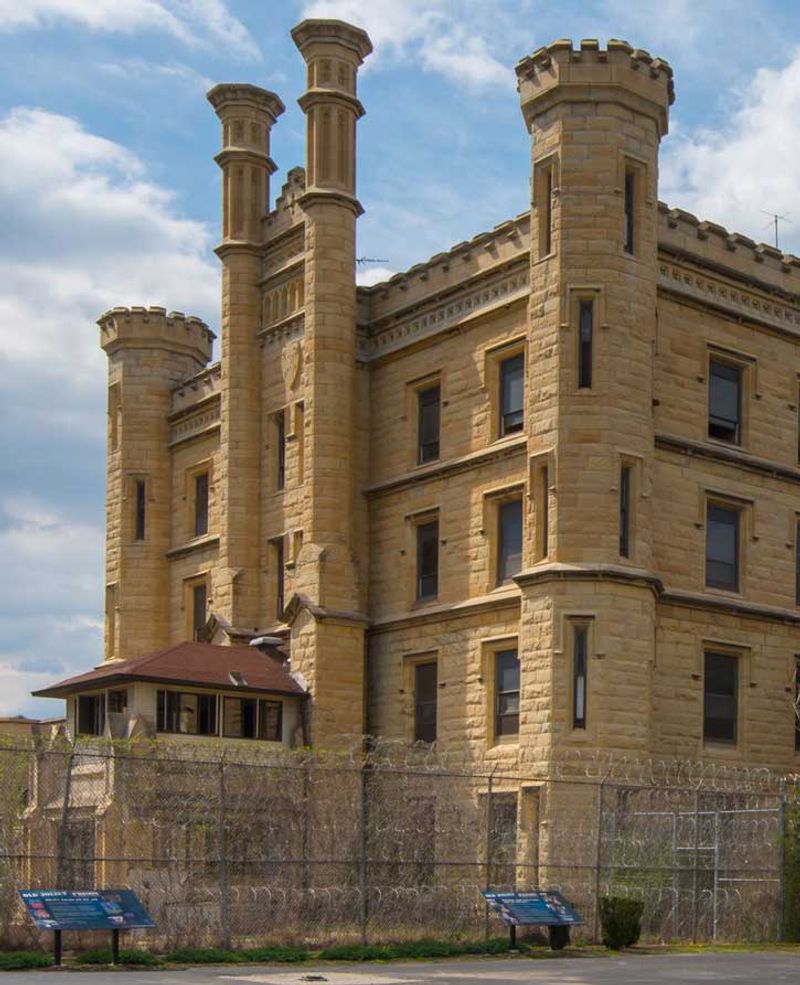
Jake and Elwood Blues put Joliet on the map, but this Illinois town has stories that go way beyond Hollywood. The old Joliet Correctional Center, now closed, once housed some of America’s most notorious criminals and served as the backdrop for countless movies and TV shows.
Music flows through Joliet’s streets like a river of rhythm. Local blues clubs keep the tradition alive, while the Rialto Square Theatre hosts world-class performances in a stunning venue that’s been entertaining audiences since 1926.
Route 66 runs right through downtown, where vintage diners serve comfort food and local shops display memorabilia from the road’s golden age.
3. Springfield, Illinois – Lincoln’s Legacy Lives On
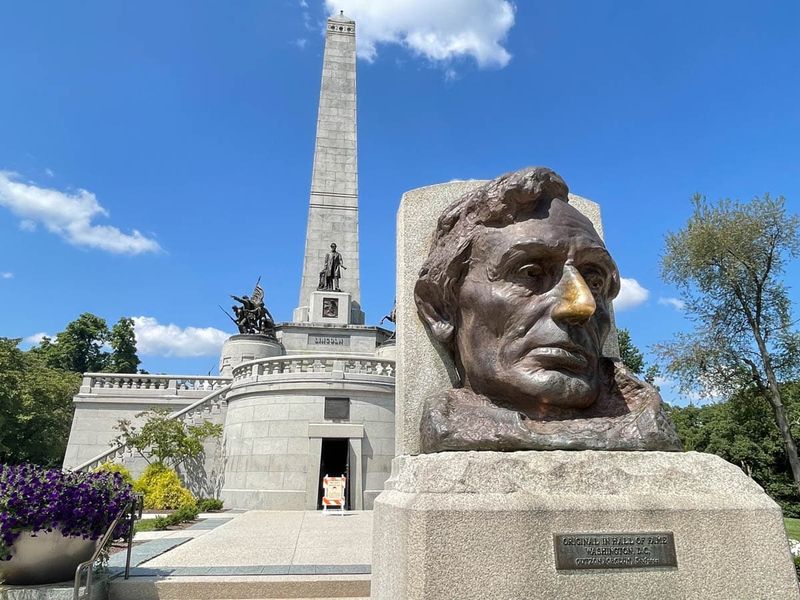
Abraham Lincoln’s hometown welcomes visitors with open arms and fascinating history around every corner. The Lincoln Home National Historic Site preserves the only home our 16th president ever owned, offering glimpses into his family life before the White House changed everything.
Oak Ridge Cemetery holds Lincoln’s tomb, where millions have paid their respects to the Great Emancipator. The impressive monument stands as a testament to his enduring legacy and the respect Americans still hold for his leadership during our nation’s darkest hour.
Downtown Springfield buzzes with cozy cafes, antique shops, and the famous Cozy Dog Drive In, birthplace of the corn dog on a stick.
4. St. Louis, Missouri – Gateway to Western Adventure
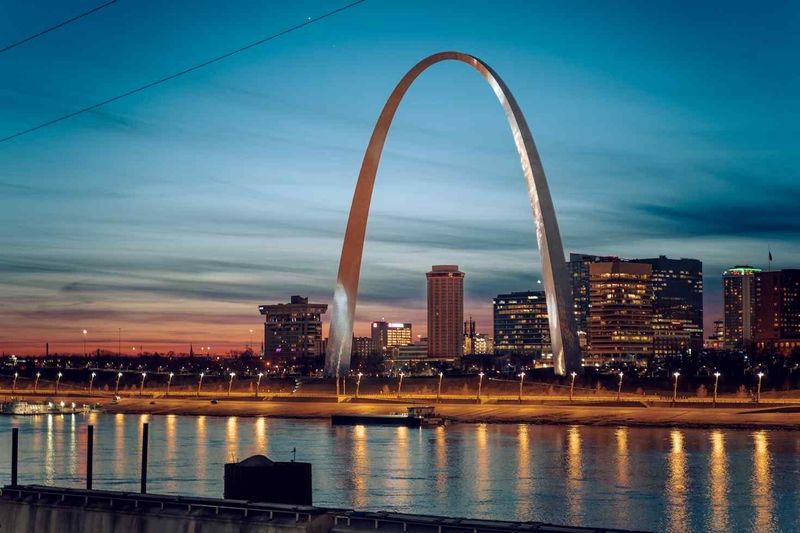
The magnificent Gateway Arch rises 630 feet above the Mississippi River, symbolizing St. Louis as the gateway to America’s western frontier. This architectural marvel offers breathtaking views from its peak and serves as a perfect photo opportunity for Route 66 travelers heading into Missouri’s heartland.
Forest Park spans 1,300 acres and houses world-class attractions including the Saint Louis Zoo, Art Museum, and Science Center. The park hosted the 1904 World’s Fair and Olympics, leaving behind beautiful pavilions and cultural institutions that continue enriching visitors today.
Barbecue joints throughout the city serve up smoky, sauce-slathered ribs that represent authentic Missouri cuisine at its finest.
5. Cuba, Missouri – The Route 66 Mural City
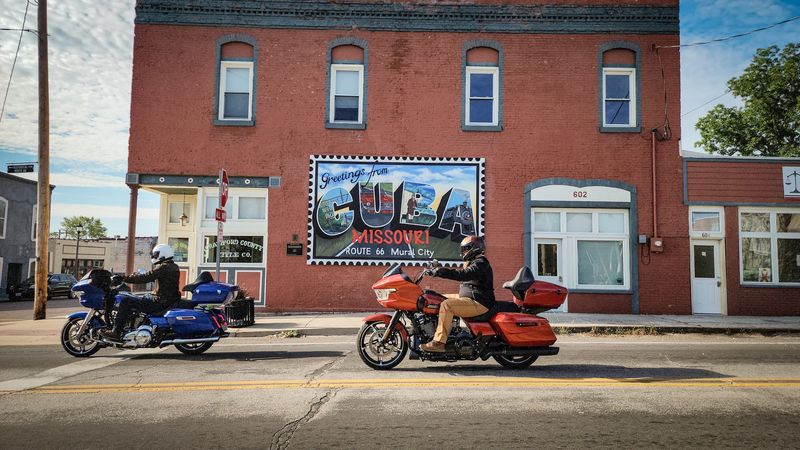
Twelve stunning murals transform Cuba’s downtown into an outdoor art gallery celebrating Route 66’s golden era. Each colorful masterpiece tells stories of travelers, local history, and the highway’s impact on small-town America, creating a walking tour that delights visitors of all ages.
The Wagon Wheel Motel maintains its vintage charm with neon signs and classic motor court architecture that transports guests back to the 1950s. Original fixtures and period decorations make every stay feel like a step back in time.
Local shops along the historic route sell handmade crafts, vintage collectibles, and Route 66 memorabilia. The town’s commitment to preserving highway history makes it a favorite stop for road trip enthusiasts.
6. Springfield, Missouri – Birthplace of the Mother Road
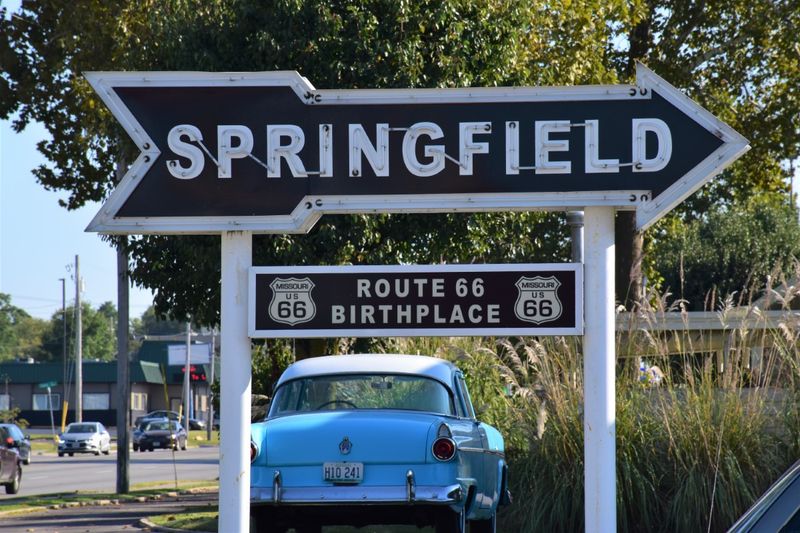
Springfield proudly claims the title “Birthplace of Route 66” because the federal highway designation originated here in 1926. The Route 66 Car Museum showcases classic automobiles that once cruised America’s highways, from pristine Corvettes to family station wagons loaded with vacation memories.
Fantastic Caverns offers underground boat tours through Missouri’s only ride-through cave system. This natural wonder maintains a constant 60-degree temperature year-round, providing cool relief during hot summer road trips and fascinating geological formations that amaze visitors.
The historic downtown square buzzes with local restaurants, antique shops, and the Discovery Center, making Springfield a perfect overnight stop for families exploring Route 66.
7. Lebanon, Missouri – Classic Diners and Highway History

The Route 66 Museum in Lebanon houses an impressive collection of highway memorabilia, vintage photographs, and artifacts that chronicle the road’s evolution from dusty trail to concrete superhighway. Interactive displays help visitors understand how this route shaped American culture and connected communities across eight states.
Munger Moss Motel has welcomed travelers since 1946 with its iconic neon sign and family-owned hospitality. The property maintains original mid-century modern architecture while providing updated amenities, creating the perfect blend of nostalgia and comfort for modern road trippers.
Local diners serve hearty portions of comfort food, from chicken-fried steak to homemade pie, fueling travelers for the miles ahead through Missouri’s rolling countryside.
8. Joplin, Missouri – Mining Heritage Meets Modern Arts
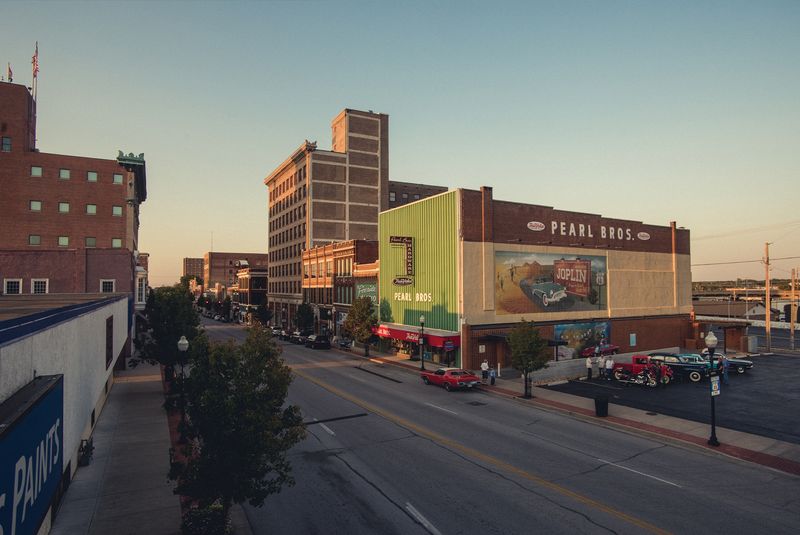
Joplin’s mining boom created incredible wealth in the early 1900s, leaving behind stunning architecture and cultural institutions that still enrich the community today. The Spiva Center for the Arts showcases regional talent while the Historic Murals Program beautifies downtown buildings with colorful depictions of local history.
Precious Moments Park and Chapel attract visitors worldwide with inspirational artwork and peaceful gardens. Creator Samuel Butcher’s vision comes to life through bronze sculptures, stained glass windows, and interactive exhibits that celebrate faith, hope, and love.
Route 66 Mural Park features a massive 30,000-square-foot painting that took local artists years to complete. The artwork depicts Joplin’s history from Native American settlements through modern times.
9. Tulsa, Oklahoma – Art Deco Architecture and Music Magic

Tulsa’s skyline showcases some of America’s finest Art Deco architecture, built during the oil boom of the 1920s and 1930s. The Boston Avenue Methodist Church stands as a magnificent example of this architectural style, with its soaring spire and intricate geometric details creating a masterpiece of design and craftsmanship.
The Woody Guthrie Center celebrates Oklahoma’s most famous folk singer and his contributions to American music and social justice. Interactive exhibits let visitors explore Guthrie’s life, lyrics, and lasting impact on generations of musicians who followed in his footsteps.
Cain’s Ballroom hosts live music performances in a venue where Bob Wills and his Texas Playboys popularized Western swing dancing during the 1930s and 1940s.
10. Oklahoma City, Oklahoma – Museums and Culinary Delights
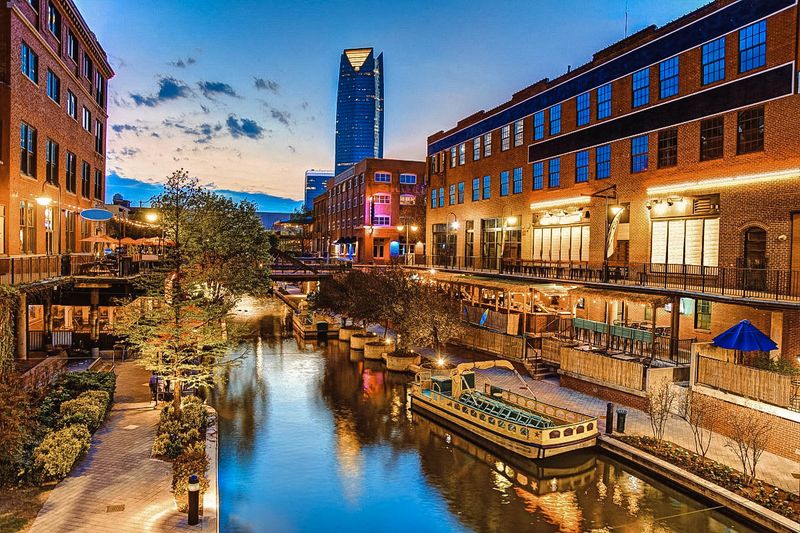
The National Cowboy & Western Heritage Museum houses the world’s largest collection of Western art and artifacts, from Native American pottery to contemporary cowboy sculptures. The museum’s Hall of Fame honors rodeo champions, Western film stars, and individuals who shaped America’s frontier heritage.
Bricktown Entertainment District transforms a former warehouse area into a vibrant neighborhood filled with restaurants, shops, and nightlife venues. The Bricktown Canal offers boat rides through the heart of the district, while the Oklahoma City Thunder creates excitement at nearby Paycom Center.
Local food trucks and restaurants serve everything from authentic barbacoa tacos to chicken-fried steak, representing Oklahoma’s diverse culinary landscape that blends Southern, Southwestern, and Native American influences.
11. Elk City, Oklahoma – Route 66 Museum and Pioneer Spirit
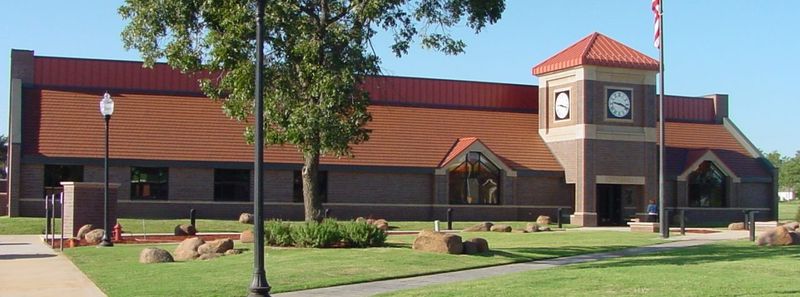
The National Route 66 Museum Complex preserves highway history through vintage automobiles, period room displays, and artifacts that tell stories of America’s most famous road. The Old Town Museum recreates a 1900s frontier settlement with authentic buildings, antique farm equipment, and pioneer artifacts.
Casa Grande Trading Post has served travelers since the 1940s with Native American jewelry, pottery, and handcrafted souvenirs. The family-owned business maintains its original charm while offering authentic items from regional artists and craftspeople who continue traditional techniques passed down through generations.
Ackley Park provides a peaceful setting for picnics and playground fun, while the nearby Elk City Lake offers fishing, boating, and swimming opportunities for families seeking outdoor recreation during their Route 66 adventure.
12. Amarillo, Texas – Cadillac Ranch and Big Texan Steaks
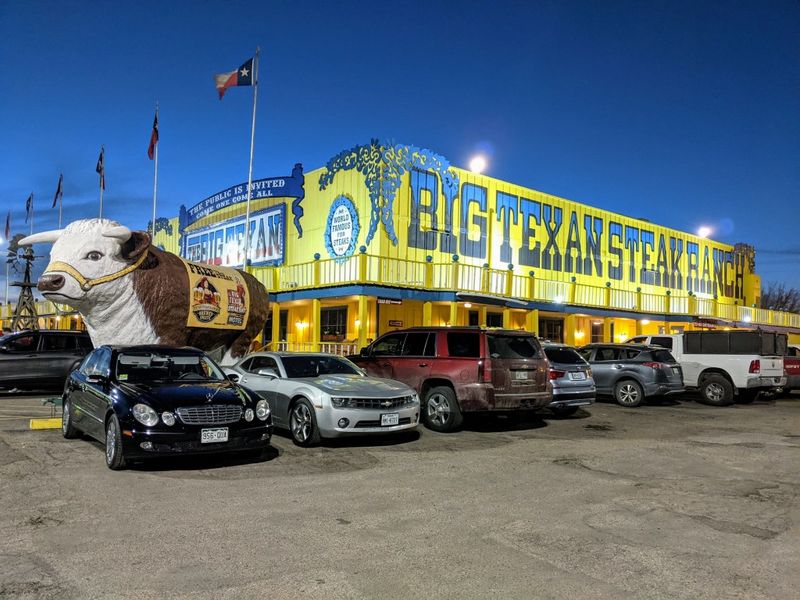
Cadillac Ranch stands as Route 66’s most famous art installation, featuring ten vintage Cadillacs buried nose-first in a wheat field west of Amarillo. Visitors are encouraged to bring spray paint and add their own artistic contributions to these automotive sculptures, creating an ever-changing masterpiece that reflects thousands of travelers’ creativity.
The Big Texan Steak Ranch offers a legendary 72-ounce steak dinner that’s free if you can finish it in one hour. This roadside institution has challenged hungry travelers since 1960, with only about 9,500 people successfully completing the massive meal out of tens of thousands who have attempted it.
Palo Duro Canyon State Park, located just southeast of Amarillo, showcases the second-largest canyon in America with stunning red rock formations and hiking trails.
13. Tucumcari, New Mexico – Neon Nights and Motor Court Magic
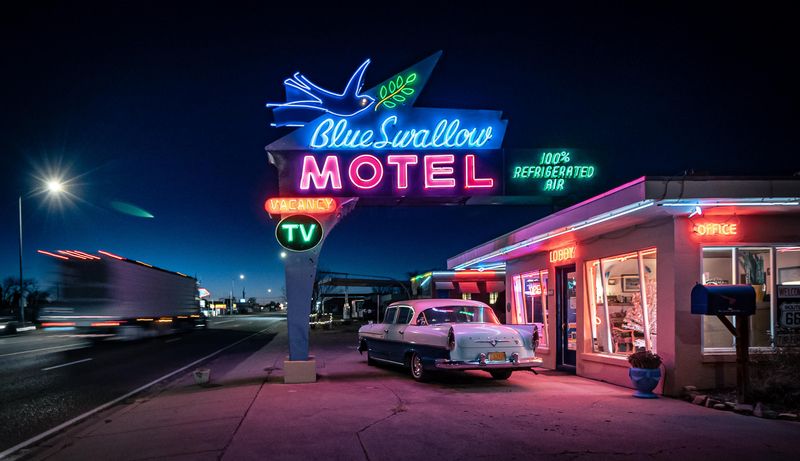
Tucumcari’s historic neon signs illuminate Route 66 with colorful displays that have welcomed travelers since the highway’s heyday. The Blue Swallow Motel maintains its 1940s charm with original neon signage, vintage furniture, and personalized service that makes every guest feel like family during their Mother Road journey.
The Mesalands Community College Dinosaur Museum houses impressive fossil collections and life-size prehistoric creature replicas. Interactive exhibits help visitors understand New Mexico’s ancient history when dinosaurs roamed the high desert landscape millions of years ago.
Local restaurants serve authentic New Mexican cuisine featuring green chile, sopaipillas, and other regional specialties. The combination of Mexican, Native American, and Anglo influences creates unique flavors that represent the cultural diversity of the American Southwest.
14. Santa Fe, New Mexico – Adobe Architecture and Artistic Soul
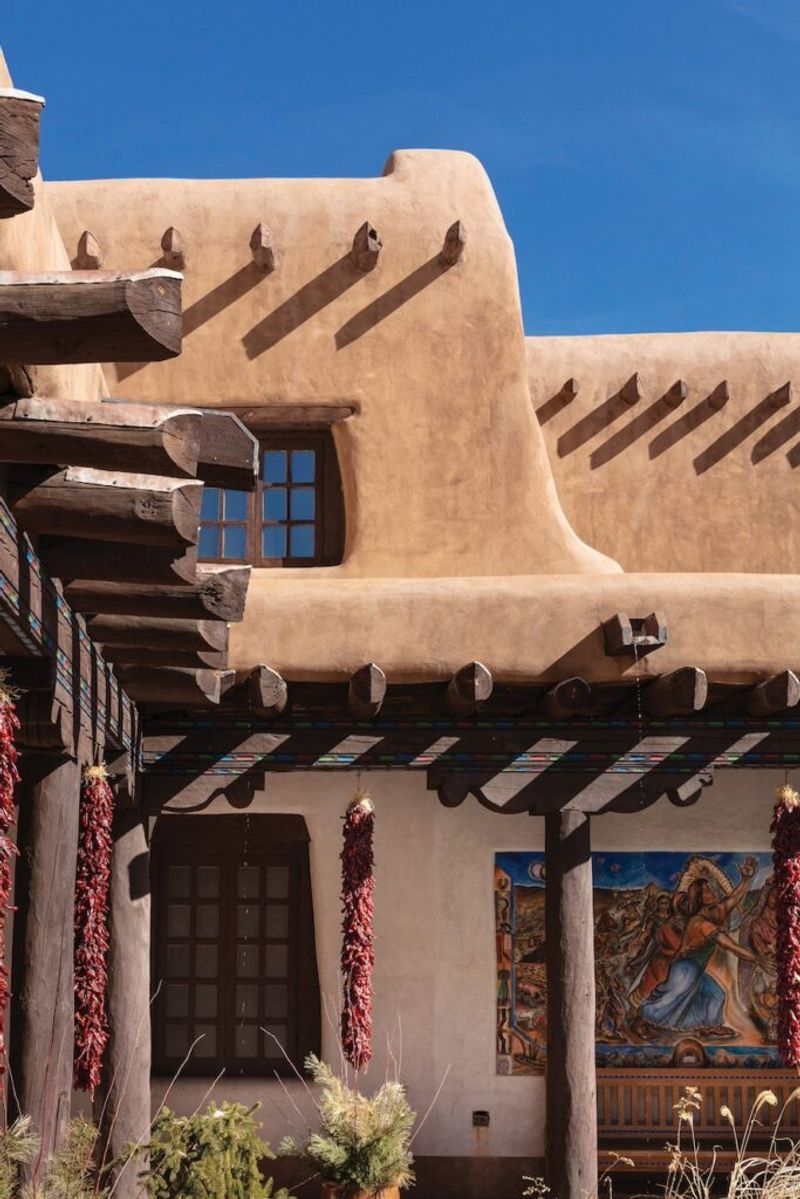
Santa Fe’s Plaza has served as the city’s heart for over 400 years, surrounded by adobe buildings that house Native American jewelry vendors, art galleries, and restaurants serving traditional New Mexican cuisine. The Palace of the Governors, built in 1610, stands as America’s oldest continuously occupied public building.
Canyon Road features over 100 art galleries, studios, and shops in a historic neighborhood where artists have worked for generations. Visitors can watch potters, painters, and sculptors create masterpieces while browsing collections that range from traditional Native American art to contemporary Southwestern works.
The Loretto Chapel’s mysterious spiral staircase attracts visitors worldwide with its seemingly impossible construction. Legend claims the staircase was built by a mysterious carpenter who disappeared without payment, leaving behind an architectural marvel that still puzzles engineers today.
15. Albuquerque, New Mexico – Old Town Charm and Route 66 Nostalgia

Old Town Albuquerque preserves 300 years of history in adobe buildings surrounding a traditional Spanish colonial plaza. San Felipe de Neri Church, built in 1793, anchors the historic district while shops and restaurants occupy structures that have sheltered merchants, craftspeople, and travelers for centuries.
The Route 66 Auto Museum showcases classic cars, vintage motorcycles, and highway memorabilia that celebrate America’s love affair with the open road. Interactive displays help visitors understand how automobiles transformed American culture and made cross-country travel accessible to ordinary families seeking adventure.
The Sandia Peak Tramway carries passengers 2.7 miles up the mountainside, offering spectacular views of the Rio Grande Valley and surrounding desert landscape. The 15-minute ride provides a bird’s-eye perspective of Albuquerque’s sprawling metropolitan area.
16. Gallup, New Mexico – Native American Culture and Trading Posts
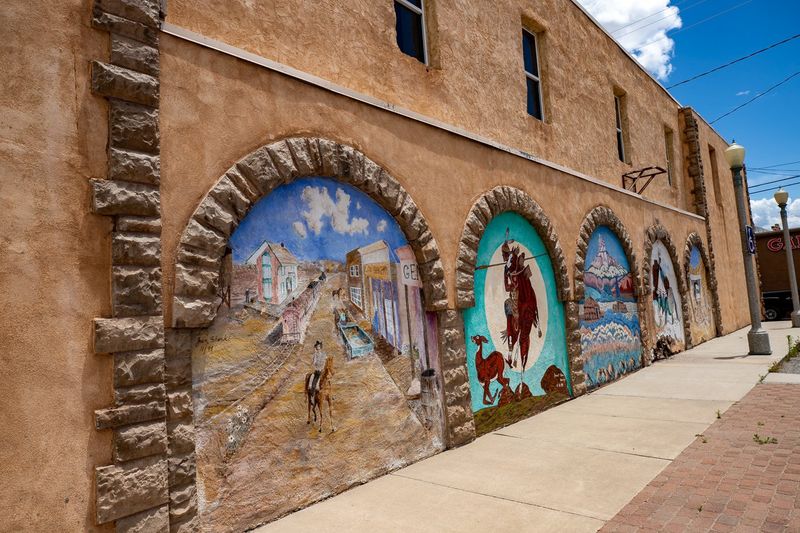
Gallup serves as the gateway to Native American country, surrounded by Navajo and Zuni reservations that maintain traditional cultures and artistic traditions. The Inter-Tribal Indian Ceremonial, held annually since 1922, brings together tribes from across North America to share dances, songs, and cultural celebrations with visitors from around the world.
Historic trading posts line Route 66 through Gallup, offering authentic Native American jewelry, pottery, rugs, and artwork created by local artisans. These family-owned businesses have served travelers and tribal communities for generations, maintaining relationships built on trust and respect for traditional craftsmanship.
The El Rancho Hotel has hosted Hollywood stars since 1937, when movie studios filmed Western movies in the surrounding high desert landscape. Guest rooms are named after famous actors who stayed here.
17. Holbrook, Arizona – Petrified Forest and Wigwam Motels

The Wigwam Motel’s fifteen concrete teepees have sheltered Route 66 travelers since 1950, offering a unique overnight experience that combines kitsch with comfort. Each wigwam contains period furniture and modern amenities, while the vintage neon sign creates perfect photo opportunities for social media-savvy road trippers documenting their Mother Road adventure.
Petrified Forest National Park, located just east of Holbrook, preserves ancient trees that turned to stone over millions of years. The park’s colorful badlands and Native American petroglyphs provide hiking opportunities and educational experiences about the region’s geological and cultural history.
Downtown Holbrook features antique shops, Western wear stores, and restaurants serving hearty portions of American comfort food. The town maintains its frontier atmosphere while welcoming modern travelers exploring Arizona’s high desert landscape along historic Route 66.
18. Flagstaff, Arizona – Gateway to Grand Canyon Adventures
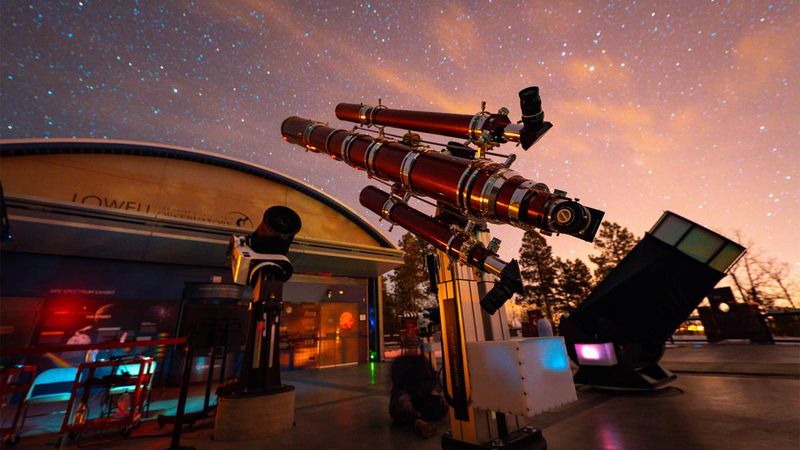
Flagstaff’s historic downtown buzzes with outdoor gear shops, craft breweries, and restaurants that cater to adventurers heading to nearby national parks and wilderness areas. The city’s 7,000-foot elevation provides cool relief during summer months while offering winter skiing at Arizona Snowbowl when conditions permit.
Lowell Observatory, founded in 1894, discovered Pluto and continues advancing astronomical research while offering public programs that let visitors explore the night sky through powerful telescopes. The facility’s dark sky location provides exceptional stargazing opportunities away from urban light pollution.
The Museum of Northern Arizona showcases regional Native American cultures, geology, and natural history through permanent exhibits and rotating displays. The museum’s research programs and educational initiatives help preserve and share knowledge about the Colorado Plateau’s unique environment and cultural heritage.
19. Seligman, Arizona – Birthplace of Route 66 Revival
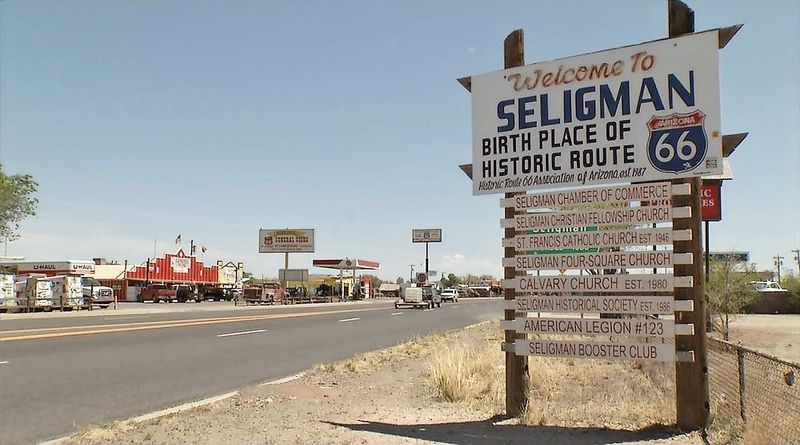
Angel Delgadillo’s barbershop and visitor center serves as headquarters for the Route 66 revival movement that began in the 1980s when interstate highways threatened to bypass historic communities. This local barber turned preservationist helped create the Historic Route 66 Association, ensuring future generations could experience America’s Mother Road.
The Rusty Bolt gift shop overflows with Route 66 memorabilia, vintage signs, and quirky souvenirs that celebrate highway culture. Owner Angel Delgadillo, now in his 90s, shares stories with visitors about the road’s golden age and his efforts to preserve its legacy for future travelers.
Seligman’s main street features classic diners, antique shops, and motor courts that maintain their 1950s atmosphere. The town’s commitment to preserving Route 66 history makes it a pilgrimage destination for highway enthusiasts from around the world.
20. Kingman, Arizona – Route 66 Museum and Desert Beauty
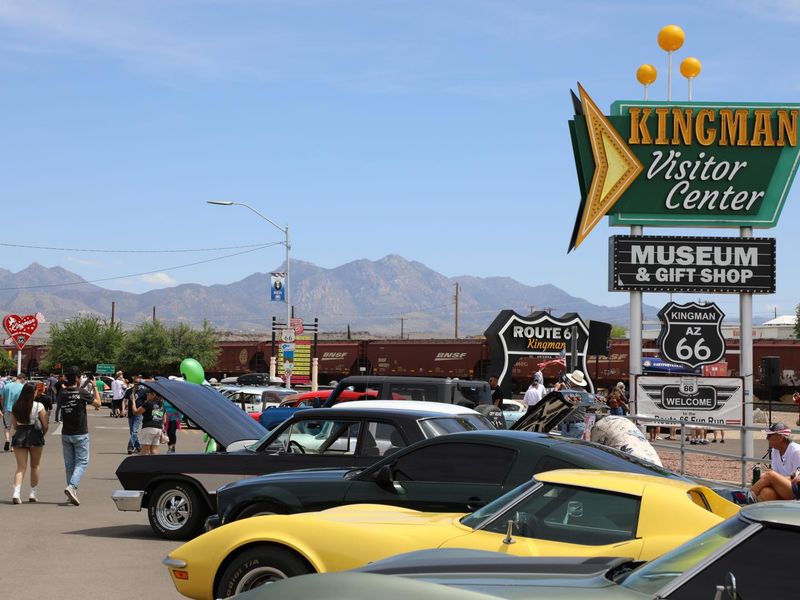
The Arizona Route 66 Museum occupies the historic Powerhouse building, showcasing highway artifacts, vintage photographs, and interactive displays that chronicle the road’s impact on American culture. The museum’s collection includes everything from classic automobiles to period advertising signs that once beckoned travelers to stop and explore.
Kingman’s location provides easy access to Hoover Dam, one of America’s greatest engineering achievements. The massive concrete arch-gravity dam controls the Colorado River while generating hydroelectric power for millions of people across the Southwest, creating Lake Mead in the process.
Local shops along Beale Street offer antiques, collectibles, and handcrafted items while restaurants serve everything from Mexican cuisine to classic American diner food. The town’s railroad heritage remains visible through historic depot buildings and nearby tracks that still carry freight trains across the desert.
21. Oatman, Arizona – Wild Burros and Old West Atmosphere
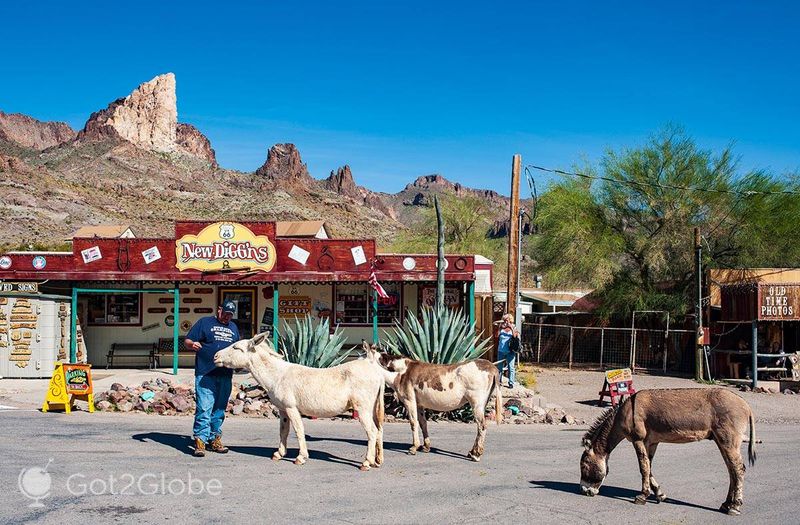
Wild burros roam Oatman’s main street, descendants of pack animals used by prospectors during the town’s gold mining heyday. These friendly creatures approach visitors seeking treats and photo opportunities, creating unique interactions that delight families traveling Route 66 through Arizona’s desert landscape.
Daily gunfight reenactments transport visitors back to the Wild West era when Oatman served as a rough mining camp filled with saloons, gambling halls, and fortune seekers hoping to strike it rich. Professional actors in period costumes perform choreographed shootouts that entertain audiences while sharing local history and legends.
The Oatman Hotel claims Clark Gable and Carole Lombard spent their honeymoon night here in 1939, though historians debate this story’s accuracy. Regardless of its celebrity connections, the historic building maintains its frontier atmosphere with original fixtures and Old West decorations.
22. Barstow, California – Route 66 Mother Road Museum
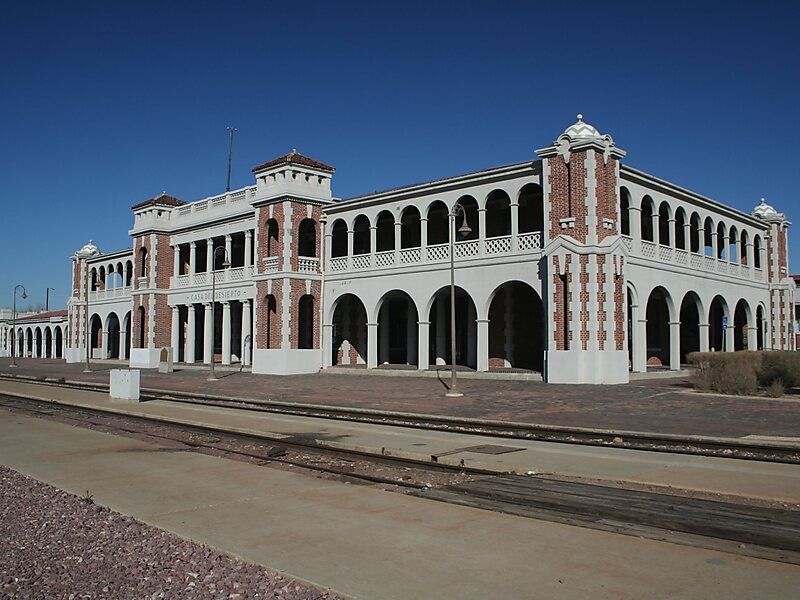
The Route 66 Mother Road Museum occupies Barstow’s historic Casa del Desierto, a beautiful Harvey House hotel that once served railroad passengers traveling between Chicago and Los Angeles. The museum’s collection includes vintage automobiles, period photographs, and artifacts that document the highway’s evolution from dirt road to concrete superhighway.
Barstow’s location in the Mojave Desert made it a crucial stop for travelers crossing California’s harsh interior landscape. The town’s railroad heritage remains visible through active freight yards and the Western America Railroad Museum, which preserves diesel locomotives and railroad cars from the mid-20th century.
Outlets at Barstow provide shopping opportunities for travelers seeking bargains on brand-name merchandise, while local restaurants serve everything from fast food to authentic Mexican cuisine. The town’s desert setting offers spectacular sunsets and clear night skies perfect for stargazing.
23. San Bernardino, California – Birthplace of Fast Food Culture
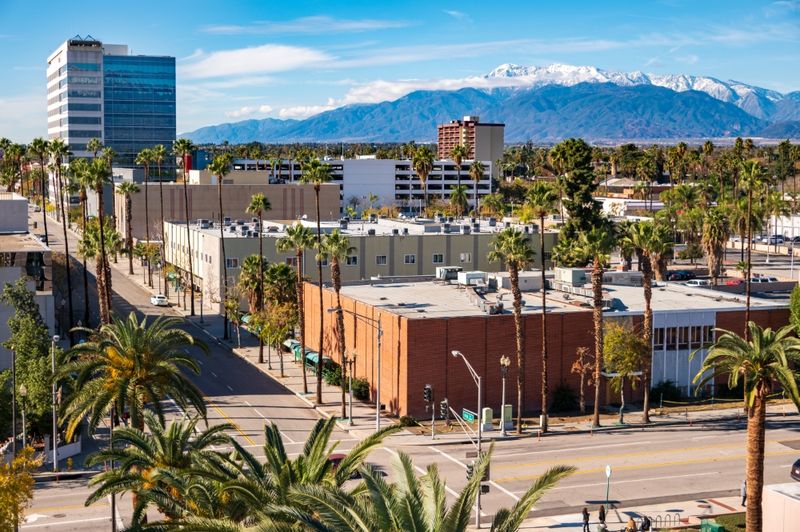
San Bernardino claims fame as the birthplace of the McDonald’s fast food empire, where brothers Richard and Maurice McDonald developed the “Speedee System” that revolutionized restaurant service in the 1940s. A museum now occupies the site of the original restaurant, showcasing artifacts and exhibits about fast food history.
The California Theatre of the Performing Arts presents live entertainment in a beautifully restored 1928 venue that survived earthquakes, economic downturns, and urban renewal projects. The theater’s Spanish Colonial Revival architecture and ornate interior details create an elegant setting for concerts, plays, and community events.
Route 66 runs through San Bernardino’s downtown area, where vintage motels, classic diners, and antique shops maintain connections to the highway’s golden age. The city’s location at the base of the San Bernardino Mountains provides scenic backdrops for photographs documenting your Mother Road journey.
24. Pasadena, California – Rose Bowl and Historic Neighborhoods
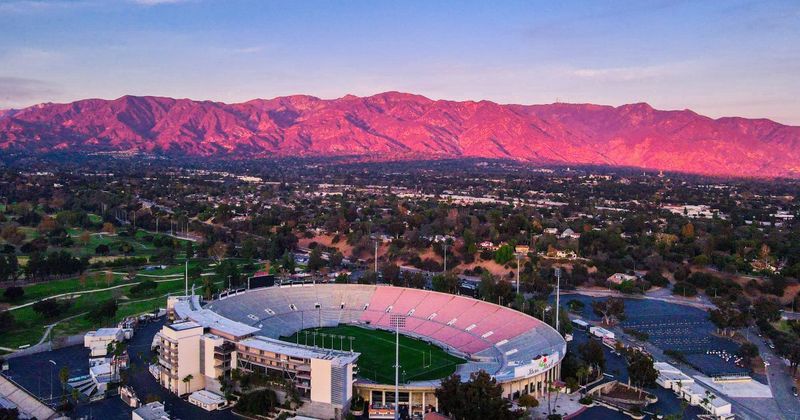
The Rose Bowl Stadium hosts the annual Tournament of Roses Parade and college football’s Rose Bowl Game, creating New Year’s Day traditions that have entertained Americans since 1902. The iconic venue also serves as a historic landmark where UCLA Bruins play home games and major concerts attract world-famous performers.
Old Pasadena’s revitalized downtown district features upscale shopping, fine dining, and entertainment venues housed in beautifully restored early 20th-century buildings. The area’s pedestrian-friendly streets and outdoor dining patios create a vibrant atmosphere that attracts locals and tourists throughout the year.
The Huntington Library, Art Museum, and Botanical Gardens showcase rare manuscripts, European paintings, and themed gardens representing different world cultures. The institution’s Desert Garden contains one of the world’s largest collections of cacti and succulents, while the Japanese Garden provides peaceful settings for reflection and photography.
25. Santa Monica, California – The End of America’s Highway
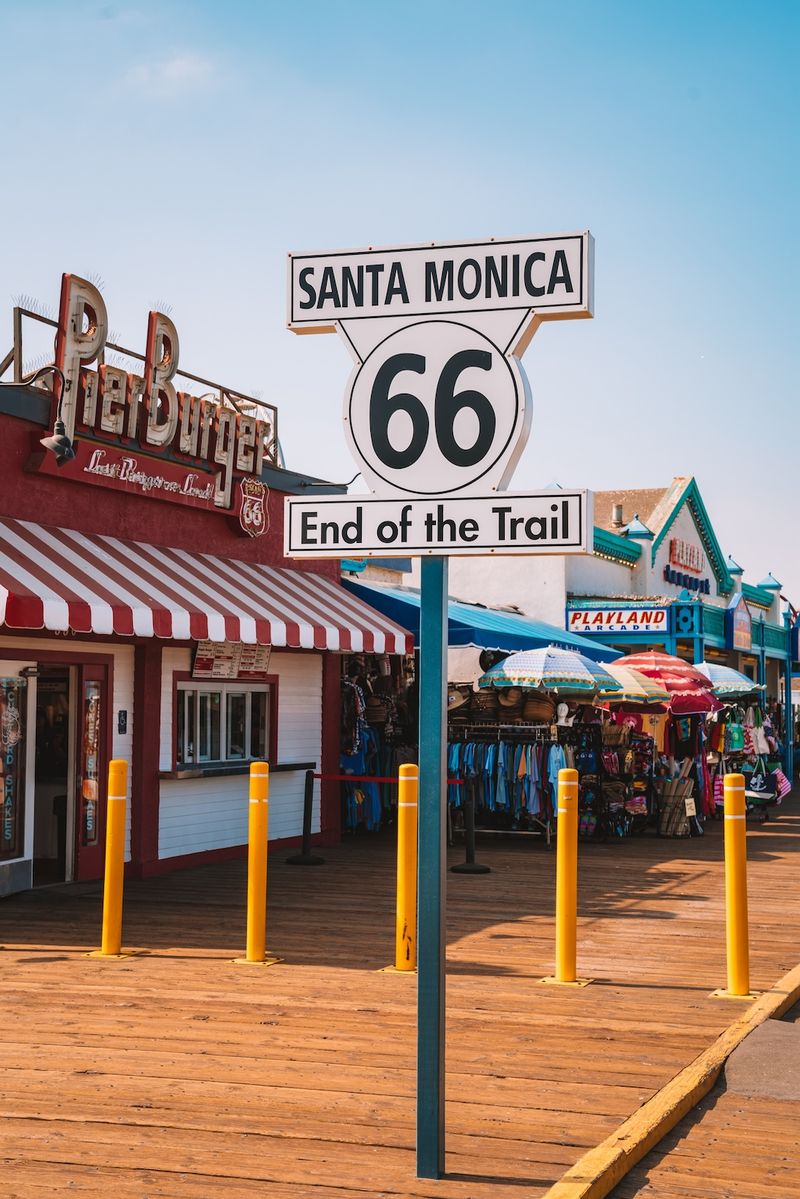
Santa Monica Pier marks the official western terminus of Route 66, where America’s most famous highway meets the Pacific Ocean after its 2,400-mile journey from Chicago. The iconic “End of the Trail” sign provides the perfect photo opportunity for road trippers celebrating their cross-country achievement on the historic Mother Road.
The pier’s amusement park features a vintage Ferris wheel, roller coaster, and carnival games that have entertained visitors since the 1920s. Street performers, musicians, and artists create a festive atmosphere while restaurants and shops offer everything from funnel cakes to fresh seafood caught in nearby waters.
Third Street Promenade and Santa Monica Place provide world-class shopping and dining experiences just blocks from the beach. The area’s year-round mild climate, beautiful sunsets, and endless entertainment options make Santa Monica the perfect destination to conclude your Route 66 adventure.

